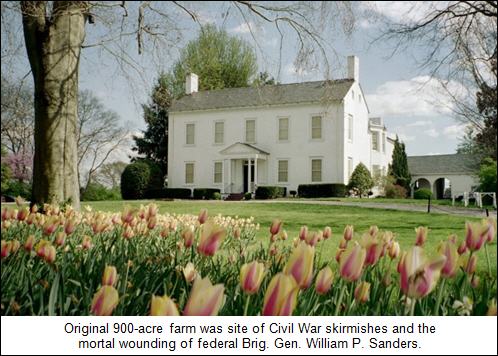|

|
|
|
|
|
Tour Seven Historic
Homes of Knoxville
|
|
Knoxville,
TN – March 2018 / Newsmaker Alert / Conveniently located just off I-40
and I-75 in eastern
Tennessee, Knoxville is a bustling city situated in the foothills of
the Great Smoky Mountains. Along with plenty of outdoor adventure in the
nearby mountains, visitors can take a step back in time and tour seven
historic homes, each one boasting a different story while celebrating more
than 200 years of unique architecture, artifacts and culture.
James
White’s Fort
James
White was an American pioneer and soldier who founded Knoxville, Tennessee.
He established his home in 1786 and later enclosed it within a log fort
comprising of 8 buildings. Restored and opened to the public in 1970, the
Fort interprets the pioneer history and culture of early East Tennessee
and is considered the birthplace of Knoxville.
Blount
Mansion
Situated
in the center of downtown Knoxville’s government district, Blount Mansion
offers history of one of the nation’s founding fathers. William Blount,
who was a signer of the U.S. Constitution as a delegate from North Carolina,
moved to Knoxville following his appointment by President Washington as
Governor of the Southwest Territory. Made of sawn lumber brought from North
Carolina, Blount Mansion would serve as the territorial capitol, as well
as a family home. Today, the landmark also features a modern visitors center
with a museum shop and historical exhibits.
Crescent
Bend House and Gardens
Built
in 1834 by Drury Paine Armstrong, Crescent Bend is named for its prominent
setting overlooking a majestic crescent bend in the Tennessee River just
west of downtown Knoxville. It was once a 600-acre working farm and was
site of Civil War skirmishes and the mortal wounding of federal Brig. Gen.
William P. Sanders. The Armstrong-Lockett House Museum at Crescent Bend
contains an extensive fine antique art and furniture collection from notable
artisans like Michael Allison, Honore Launnier, Benjamin Frothingham, Samuel
McIntire, and Sir Thomas Lawrence. Also on display is an outstanding American
and English Silver collection dating back to the 16th century.
|
 |
|
Historic
Westwood
Historic
Westwood was built as a wedding promise in 1890 by John Edwin Lutz and
his wife, Ann Adelia Armstrong Lutz. Adelia Lutz was Tennessee’s first
professional female painter and the house is filled with her beautiful
hand-painted decorative frescos. Originally sited on 12 acres along Kingston
Pike, the home was designed by notable architects Baumann Brothers and
placed on the National Register of Historic Places in 1984.
Mabry-Hazen
House
Mabry-Hazen
House, listed on the National Register of Historic Places, is located atop
scenic Mabry’s Hill in Knoxville. Built in 1858 and housing three generations
of the same family from 1858 to 1987, Mabry-Hazen House served as headquarters
for both Union and Confederate forces during the Civil War. Visitors to
the historic site can view original artifacts including china, silver,
crystal, and antique furnishings.
Historic
Ramsey House Plantation
The
historic Ramsey House Plantation is the family home built Colonel Francis
A. Ramsey in 1797. The Ramseys were an influential East Tennessee family
with ties to the Confederacy, railroad development, the University of Tennessee,
and early public medical care. The home is constructed of Tennessee pink
marble and blue limestone and was well known at that time as the finest
home in Tennessee. The self-supporting working farm originally was composed
of over 2000 acres of prime farmland. Today, the farmstead consists of
110 acres on which the family mansion sits. Guided tours are given daily
by trained docents. Visitors can tour the homestead, which contains many
fine furnishings and housewares of the period and take a leisurely walk
around the grounds.
Marble
Springs State Historic Site
Marble
Springs State Historic Site is a scenic 35-acre homestead of the first
governor of Tennessee, John Sevier. The main cabin, built circa 1800, still
stands today on the site where it was originally constructed. Along with
the cabin, Marble Springs State Historic Site consists of a tavern, loom
house, spring house, smoke house and trading post that give visitors a
glimpse into late 18th and early 19th-century life. It was placed on the
National Register of Historic Places in 1971. The historic site and home
contain several original furnishings belonging to the Sevier family. Tours
are available of the historic site or visitors can walk the hiking trails
exploring a beautiful nature setting just 12 miles outside of downtown
Knoxville.
“Each
historic home has their own unique story to tell. In addition, each site
offers special events throughout the year, guided tours and rental options,”
said Julie Graham, spokesperson for the Tennessee River Valley Mapguide
Council.
Visitors
can visit each site individually, or visit all of the sites by purchasing
a discounted combo pass at any of the seven locations or from the Knoxville
Visitors Center. For complete trip plan details including directions, admission
fees, and hours of operation, visit www.tennesseerivervalleygeotourism.org.
Along
with these intriguing historical homes, the Tennessee River Valley offers
a compelling story, captivating visitors with its little unknown facts,
pristine, untouched areas and rich, authentic experiences. Plan a trip
easily with the Tennessee
River Valley Geotourism MapGuide, an online guide to explore authentic
places and adventures that have been recommended by locals.
Media
Contact:
Julie
Graham
Tennessee
River Valley Mapguide Council
865-585-0811 |





